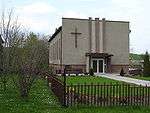Wola Piotrowa
| Wola Piotrowa (Lemko: Vola Petrova) | |
| Village | |
| The Pogórze Bukowskie is a hilly region (thus the name, Bukowsko hilly region) in Poland (Wola Piotrowa view. | |
| Name origin: Its name comes from the west slavic dialect word Wola and Piotr, meaning exactly little village of Peter | |
| Nickname: Piotrowa | |
| Country | Poland |
|---|---|
| Region | Sanok County |
| District | Gmina Bukowsko |
| River | Pielnica, Sanoczek |
| Elevation | 270 m (886 ft) |
| Coordinates | 49°27′4.89″N 22°02′37.25″E / 49.4513583°N 22.0436806°ECoordinates: 49°27′4.89″N 22°02′37.25″E / 49.4513583°N 22.0436806°E |
| Area | 8.8 km2 (3 sq mi) |
| Population | 280 (31 December 2002) |
| Density | 32/km2 (83/sq mi) |
| First mentioned | 1526 |
| Mayor | sołtys Jan Hołomek |
| Timezone | CET (UTC+1) |
| - summer (DST) | CEST (UTC+2) |
| Postal code | 38 507 |
| Car plate | KUS, RSA |
 Location of Wola Piotrowa in Sanok County | |
| Wikimedia Commons: Pogórze Bukowskie | |
| Website: http://www.bukowsko.pl | |

Wola Piotrowa [ˈvɔla pʲɔˈtrɔva] (Ukrainian: Воля Петрова, Volia Petrova) is a village in East Małopolska in the Bukowsko Upland mountains, Bukowsko rural commune, Latin parish in Bukowsko, Protestant parish in loco.
Wola Piotrowa is about 17 miles from Sanok in southeast Poland. It is situated below the main watershed at the foot of the Słonne Mountain, and has an elevation of 340 metres. Situated in the Subcarpathian Voivodship (since 1999), previously in Krosno Voivodship (1975-1998) and Sanok district, (10 miles east of Sanok), located near the towns of Medzilaborce and Palota (in northeastern Slovakia).
Forcible Deportation (Ethnic Cleansing) of Lemkos
The history of Wola Piotrowa, which had been a mostly Lemko-Ukrainian village prior to 1946, is inextricably linked to long-standing Polish/Ukrainian ethnic disputes over the territories of Galicia and Volhynia. Soviet and Polish communist collaborators were responsible for population exchanges that occurred between 1944 and 1947. Those population exchanges, intended to achieve an ethnically cleansed post-war order in the expanded Soviet Union and in Poland, included the forcible expatriation of ethnic Ukrainians from Wola Piotrowa and other villages in Galicia. (This was part of a larger population exchange arrangement with the Soviet Union between 1945 and 1946. That agreement also involved deporting ethnic Poles from Western Ukraine, and deporting Ukrainians and Rusyns from the Lemko Region in Southeast Poland to deprive support to UPA.) After the final expulsion of ethnic Ukrainians in Wola Piotrowa in 1946 (the expulsion and burning of this village pre-dated Operation Vistula), Polish communists burned down this village (and many others) likely for the purpose of deterring the expelled Lemkos from resettling in the village. According to "Church in Ruins" by Oleh Wolodymyr Iwanusiw, Wola Piotrowa established a Greek Catholic church (tserkva) in 1921 named "St. Michael the Archangel." The church was a filial parish to the church in Karlykiv (Karlikow), St. Paraskevia (est. 1840.) According to Iwanusiw, the church in Wola Piotrowa was destroyed during the post World War II period: "The tserkva here was taken apart and the materials used for the erection of Polish collective farm facilities. Only a cross marks the spot where the temple once stood."
Twin cities
Literature
- Tarnovich, Julian. Illustrated History of Lemkivshchyna. (Ukrainian Language Publication) Lviv, 1935, Reprinted in New York, NY 1964.
- Iwanusiw, Oleh Wolodymyr. Church in Ruins/Церква в руїнi (English/Ukrainian Edition) A Publication of St. Sophia Religious Association of Ukrainian Catholics in Canada, St. Catharines, 1987. Volya Petrova, retrieved March 8, 2012.
- Prof. Adam Fastnacht. Slownik Historyczno-Geograficzny Ziemi Sanockiej w Średniowieczu (Historic-Geographic Dictionary of the Sanok District in the Middle Ages), Kraków, 2002, ISBN 83-88385-14-3.
- Krasovsky, Ivan. Surnames of Galician Lemkos in the 18th Century. Lemko Foundation & Library, L'viv, 1993.
- Shematism of the Greek Catholic Apostolic Administration of Lemkivshchyna. (Ukrainian Language Publication.) Original Printing in 1936, Lviv. Reprinted in 1970 by the Ukrainian Museum & Library of Stamford, CT. See p. 6, entry on Karlykiv.
- Jerzy Zuba. "W Gminie Bukowsko." Roksana, 2004, ISBN 83-7343-150-0 (Polish). English translation of 1999 edition (ISBN 83-87282-84-7), Deborah Greenlee, Editor, 2005, Arlington, TX 76016.
External links
- "Village Histories and Surnames" - Weblog, The Lemko Project. http://lemkoproject.blogspot.com/p/village-histories-and-surnames.html
- Maps and Additional Information on Wola Piotrowa on Philip Semanchuk's website, courtesy of Jerzy Cwiakala. http://semanchuk.com/gen/data/WolaPiotrowa/
- Wola Piotrowa
- Caritas in Zboiska
- Castle in Zboiska
